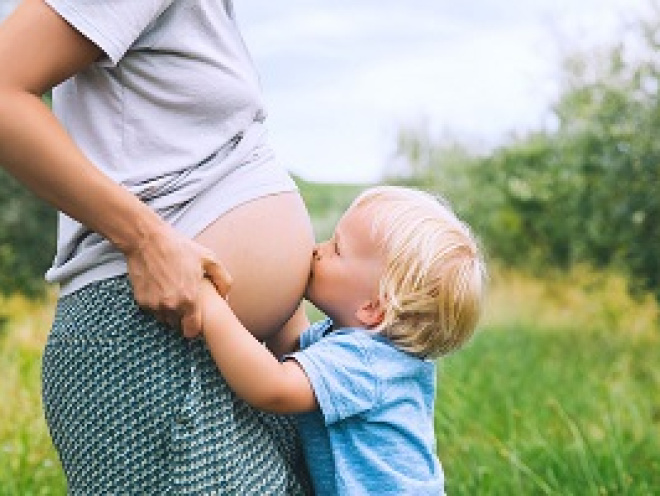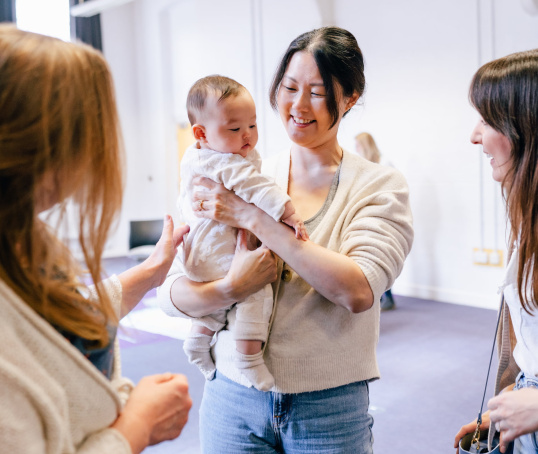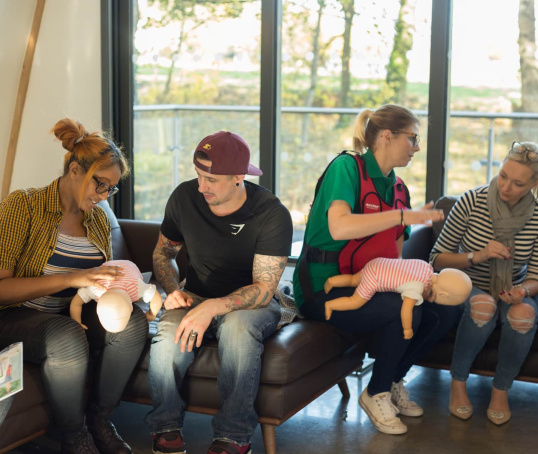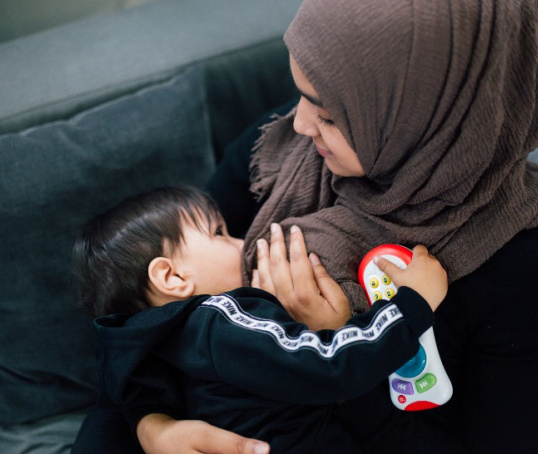There’s no doubt that child number two can have their elder sibling’s cute babygrows and booties, but what about the rest? Or maybe it's your first but you want to choose sustainably rather than buying new. Here’s your guide…
Which baby items should I buy new?
Mattresses
It might not seem like a big deal to reuse mattresses from your eldest child’s Moses basket or cot, or accept a hand-me-down from a friend. But bear in mind that doing this could mean a small increase in your baby’s risk of SIDS (Tappin et al, 2002). That applies if you’re using one that’s come from outside your house and if you lent it to somebody else in between babies.
You could do extra checks by making sure the mattress you use was completely protected by a waterproof cover when it was used. Also check it is in a good condition without rips or tears (Lullaby Trust, 2019).
See The Lullaby Trust for more information.
Car seats
Car seats from your eldest child that haven’t been used outside your family are all good to reuse. But if they’ve been used by someone you don’t know, you can’t be sure whether they’ve been in a car crash. A crash could make baby car seats unsafe (ROSPA, 2018). Plus, second hand seats often have missing safety instructions, which makes it hard to know how to fit and use it correctly.
Another consideration is that safety improvements are being made all the time. So if the seat is old, you can probably find safer ones on the market. ROSPA say to look for current safety mark (ROSPA, 2018). See our handy tips about how to choose car seats and take a look at ROSPA’s checklist for second-hand seats for more details
What might I want to get new?
Breast pumps
While no cases of babies getting sick from infections after using a second-hand breast pump have been reported, it could happen (Which? 2019). So you might want to pick up a new pump or hire a hospital grade multi-user pump from a trusted source.
Bottles
As long as they’re not broken or warped, bottles are fine to reuse. You’ll just need to buy some new teats.
Dummies
While there is no firm evidence, dummies that have already been used by one child can be cracked or have damage to the plastic. So it’s a better idea, if you’re using them, to pick up a new set for each baby.
Shoes
We know, an odd one. But there is some suggestion that shoes shouldn’t be worn by more than one child because they’ll have ‘moulded’ to the first child’s feet (IOCP, 2018).
There’s also an argument that their elder sibling (or other child) might have scuffed them and jumped in endless muddy puddles… So a new pair may be a good idea on all counts. For more about shoes, see our article about how to choose shoes for toddlers.
Second-hand is fine (as long as you do good checks)
Pushchairs
Before you reuse the pushchair that you had for your older child – or anyone else - make sure that:
- the brakes are working
- the wheels are lined up right
- the folding parts work smoothly
- the locking mechanism works (so the pushchair won’t collapse when your baby’s in it)
- there’s no rust or flaking paint or chrome
- the fabric’s in good condition with no tears
- the handles and frame don’t have any unusual bends or kinks
- it has a five-point harness (to meet current safety standards).
(Healthy Children, 2015; Which?, 2019)
Stair gates
Stair gates that stop speedy toddlers going AWOL up to your bedroom should be fine for round two, but again a few checks are useful. Make sure that:
- the bars or slats are no more than 5.5cm apart (current safety standards: BS EN 1930)
- the stair gate isn’t damaged or badly worn
- there are no holes that could trap fingers or footholds for climbing, and no sharp edges or things sticking out that could cut or catch
- the stair gate fits firmly in place with no more than 5cm between it and the floor
- locks are working right and need a bit of force, and two different types of actions to open them
- no-one has painted or varnished the gate since it was last used - the finish might contain hazardous chemicals.
(Sengölge and Vincenten, 2013; Safe Kids, 2014; NHS, 2019)
High chairs
You guessed it – check time. So, you’re looking to make sure that your high chair:
- is still stable – go for one with a wide base
- is sturdy - choose a metal or wooden frame, not plastic only
- is not missing any screws, tubing caps or bolts, check they’re not coming loose either
- has working locks and catches
- has a removable tray that locks on and your child can’t pull off
- has no sharp edges or cracks on the plastic tray that could hurt your baby
- has no exposed foam on padded parts
- has no flaking paint or splinters
- still has a working integral five-point harness (two waist straps, two shoulder straps and a crotch strap) that’d fasten around your child’s belly.
(Sengölge and Vincenten, 2013; Safe Kids, 2018; NHS, 2019)
Slings and carriers
Sling and carriers can last remarkably well from child to child and you can often pick up a second hand bargain online. Make sure you are buying from a trusted source as there are some fakes out there that may not have been safety tested (South London Slings, 2019).
It is important to check your sling or carrier before each use for signs of wear and tear, ensuring that all parts are present and in working order (Knowles, 2019). It is important to read and follow the manufacturer's instructions. Find out more about using slings and carriers safely.
Cots
If you are reusing your old cot, re-familiarise yourself with the instructions and make sure it is clean and in good condition. If you are given a used cot, it may be a good idea to replace the mattress as mentioned above.
It is also very important to read the assembly and use instructions. You can usually find them online if they are not passed on with the cot.
A few things to check with a second hand cot is that:
- It is at least 50cm deep from the mattress top to the top of the rails (60cm including the mattress).
- It has vertical bars with no more than 6cm of space between them.
- It's less than 10 years old.
- It has a firm base.
- It allows no more than two fingers width between it and the edge of the mattress (see above about mattresses).
- If the cot has a drop-down side mechanism, it's important to make sure it works properly. You should be confident it's secure and won't drop accidentally. If in doubt, it's safer not to use the cot.
- It does not have a headboard or footboard.
- It has no knobs or corner posts (if you saw them off from wood, you’ll need to sand it smooth).
(Sengölge and Vincenten, 2013; ROSPA, 2019)
For more on buying or using second-hand cots, see our article Cot safety, bedding and bumpers: your questions answered.
Which baby items can definitely be reused?
Some things you don’t need to worry about and can happily reuse include:
- clothes
- cot (though see above re mattresses)
- baby baths.
This page was last reviewed in March 2019
Further information
Our support line offers practical and emotional support with feeding your baby and general enquiries for parents, members and volunteers: 0808 506 8381.
We run Refresher antenatal courses, which are a good way of concentrating on the second baby and this pregnancy - often overlooked when there are toddlers and other children to look after. They are also a great way of meeting other parents and making a friendship group for the new addition.
Having two children – whatever the age gap – can be expensive. With two children close in age, you might find that you need to have two of everything if your toddler is still using equipment that your baby needs like the high chair. Find out what benefits you’re entitled too and also save money by picking up second-hand bargains at a local NCT Nearly New Sale.
You might find attending one of our NCT New Baby groups helpful as they give you the opportunity to explore different approaches to important parenting issues with a qualified group leader and other new parents in your area.
Make friends with other parents-to-be and new parents in your local area for support and friendship by seeing what NCT activities are happening nearby.
Car Seat Advice UK. (2019) Car seat advice FAQ.
Healthy Children. (2015) Buy a safe stroller.
IOCP (The Institute of Chiropodists and Podiatrists). (2018) Foot care for babies & small children. https://iocp.org.uk/footcare-advice/foot-care-babies-small-children/ [Accessed 1st March 2019]
Knowles R. (2019) How to use a sling safely [Online] Available from: https://www.carryingmatters.co.uk/sling-safety-how-to-use-a-sling-safel… [Accessed 1st March 2019]
NHS. (2019) Baby and toddler safety. Available from: https://www.nhs.uk/conditions/pregnancy-and-baby/baby-safety-tips/ [Accessed 1st March 2019]
ROSPA. (2019) Bedtime: a safe cot. Available from: https://www.rospa.com/Resources/Hubs/Keeping-Kids-Safe-(1)/Bedtime.aspx [Accessed Jan 2020].
Safe Kids. (2014) Choosing a child or baby safety gate. Available from: http://www.safekids.co.uk/ChildSafetyGates.html [Accessed 1st March 2019]
Safe Kids. (2018) All about highchair safety. Available from: http://www.safekids.co.uk/about-highchair-safety.html [Accessed 1st March 2019]
Sengölge M, Vincenten J. (2013) Child safety product guide: potentially dangerous products. Birmingham: European Child Safety Alliance, EuroSafe. Available from: https://www.childsafetyeurope.org/publications/info/product-safety-guide.pdf [Accessed 1st March 2019]
South London Slings (2019). Untested baby carriers and illegal fakes.
Tappin D, Brooke H, Ecob R, Gibson A. (2002) Used infant mattresses and sudden infant death syndrome in Scotland: case-control study. British Medical Journal. 2, 325(7371):1007. [Online] Available from: https://www.ncbi.nlm.nih.gov/pubmed/12411359 [Accessed 1st March 2019]
The Lullaby Trust. (2019) The best mattresses and bedding for your baby. Available from: https://www.lullabytrust.org.uk/safer-sleep-advice/mattresses-and-beddi… [Accessed 1st March 2019]
Which? (2019) How to buy the best breast pump. Available from:https://www.which.co.uk/reviews/breast-pumps/article/how-to-buy-the-best-breast-pump [Accessed 1st March 2019]






